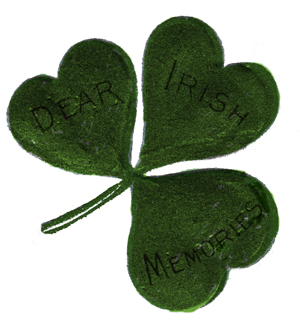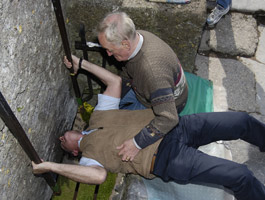|
|
|
|

 Leprechauns
Leprechauns
One of the first things people think of in association with St.Patrick's Day is the leprechaun. Leprechauns are little make-believe fairies from Ireland. They look like a small, old man standing about two feet tall (The name leprechaun derives from the old Irish word "luchorpan", meaning "little body") and usually dressed like a shoemaker, with a cocked hat and a leather apron. According to legend, leprechauns are cute, mischievous, and playful creatures who love to drink, dance, and play music, and who pass the time making shoes. They are also believed to possess a hidden pot of gold. Treasure hunters can often track down a leprechaun by the sound of his shoemaker's hammer. If caught the leprechaun must grant his captor three wishes. However, the captor must keep their eyes on him every second. If the captor's eyes leave the leprechaun for even one second (and he often tricks them into looking away), he vanishes and all hopes of finding the treasure are lost.
The true origin of the leprechaun is much more serious. The ancient origins of what we know today as the leprechaun was a Euro-Celtic god named Lugh (pronounced "Luck"). Lugh was as important a god to the ancient Euro-Celtic religion as Jesus is to our own Christianity. Lugh was the great Sun God of the Irish and Euro-Celts, patron of Arts and Crafts, leader of the Tuatha de Danaan. Many European cities were named for Lugh such as London, Leon, Loudan, Lyons, and others.
|
|
|
Shamrock
In written English, the first reference to the Shamrock dates from 1571, and in written Irish, as seamrog, from 1707. As a badge to be worn on the lapel on the Saint's feast day, it is referred to for the first time as late as 1681. The
Shamrock was used as an emblem by the Irish Volunteers in the era of Grattan's Parliament in the 1770's, before '98 and The Act of Union. So rebellious did the wearing of the Shamrock eventually appear, that in Queen Victoria's time Irish regiments were forbidden to display it. At that time it became the custom for civilians to wear a little paper cross colored red and green.
As a symbol of Ireland it has long been integrated into the symbol of the United Kingdom, along with the Rose, the Thistle and the Leek of England, Scotland and Wales. So today, on St. Patrick's Day, a member of the British Royal Family
 THE MAGIC SHAMROCK THE MAGIC SHAMROCK
Three is Ireland's magic number. Hence the Shamrock. Crone, Mother and Virgin. Love, Valour and Wit.. Faith, Hope and Charity. Father, Son and Holy Spirit. Numbers played an important role in Celtic symbolism. Three was the most sacred and magical number. It multiplies to nine, which is sacred to Brigit. Three may have signified totality: past, present and future OR behind, before and here OR sky, earth and underworld. Everything good in Ireland comes in threes. The rhythm of story telling in the Irish tradition is based on threefold repetition. This achieves both intensification and exaggeration. Even today in quality pub talk, a raconteur can rarely resist a third adjective, especially if it means stretching a point. "Three accomplishments well regarded in Ireland: a clever verse, music on the harp, the art of shaving faces."
|
|
|
 THE BLARNEY STONE THE BLARNEY STONE
The Blarney Stone is a stone set in the wall of the Blarney Castle tower in the Irish village of Blarney. Kissing the stone is supposed to bring the kisser the gift of persuasive eloquence (blarney). The castle was built in 1446 by Cormac Laidhiv McCarthy (Lord of Muskerry) -- its walls are 18 feet thick (necessary to thwart attacks by Cromwellians and William III's troops). Thousands of tourists a year still visit the castle. The origins of the Blarney Stone's magical properties aren't clear, but one legend says that an old woman cast a spell on the stone to reward a king who had saved her from drowning. Kissing the stone while under the spell gave the king the ability to speak sweetly and convincingly. It's tough to reach the stone -- it's between the main castle wall and the parapet. Kissers have to stretch to their back and bend backward (and downward), holding iron bars for support.
|
|
THERE IS A STONE THAT WHOEVER KISSES,
OH! HE NEVER MISSES TO GROW ELOQUENT
‘TIS HE MAY CLAMBER TO A LADY’S CHAMBER
OR BECOME A MEMBER OF PARLIAMENT.
-Francis Sylvester Mahony-
The Stone of Eloquence
For over 200 years, world statesmen, literary giants, and legends of the silver screen have joined the millions of pilgrims climbing the steps to kiss the Blarney Stone and gain the gift of eloquence. Its powers are unquestioned but its story still creates debate.
Some say it was Jacob’s Pillow, brought to Ireland by the prophet Jeremiah. Here it became the Lia Fail or ‘Fatal Stone’, used as an oracular throne of Irish kings – a kind of Harry Potter-like ‘sorting hat’ for kings. It was also said to be the deathbed pillow of St Columba on the island of Iona. Legend says it was then removed to mainland Scotland, where it served as the prophetic power of royal succession, the Stone of Destiny.
When Cormac MacCarthy, King of Munster, sent five thousand men to support Robert the Bruce in his defeat of the English at Bannockburn in 1314, a portion of the historic Stone was given by the Scots in gratitude – and returned to Ireland.
Others say it may be a stone brought back to Ireland from the Crusades – the ‘Stone of Ezel’ behind which David hid on Jonathan’s advice when he fled from his enemy, Saul. A few claim it was the stone that gushed water when struck by Moses.
Whatever the truth of its origin, we believe a witch saved from drowning revealed its power to the MacCarthys.
|
|
|
"May God grant you always...A sunbeam to warm you, a moonbeam to charm you,
a sheltering Angel so nothing can harm you. Laughter to cheer you.
Faithful friends near you. And whenever you pray, Heaven to hear you."
|
|
|
|
"Irish Blessings"
(view flash video - click "Start" in the screen above)
| | | | |